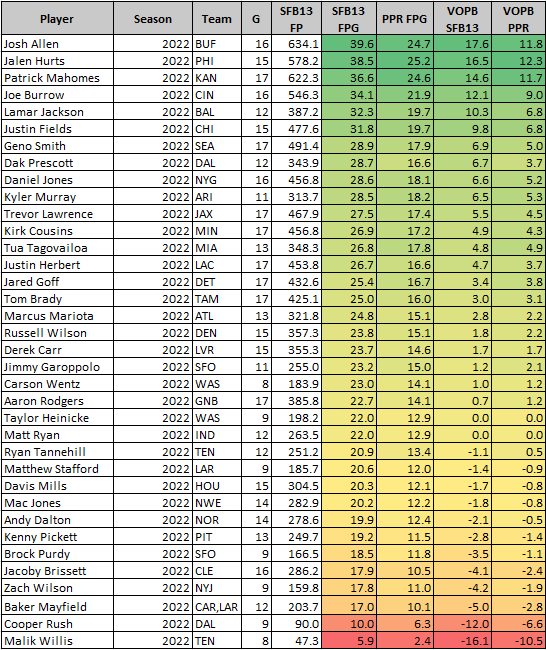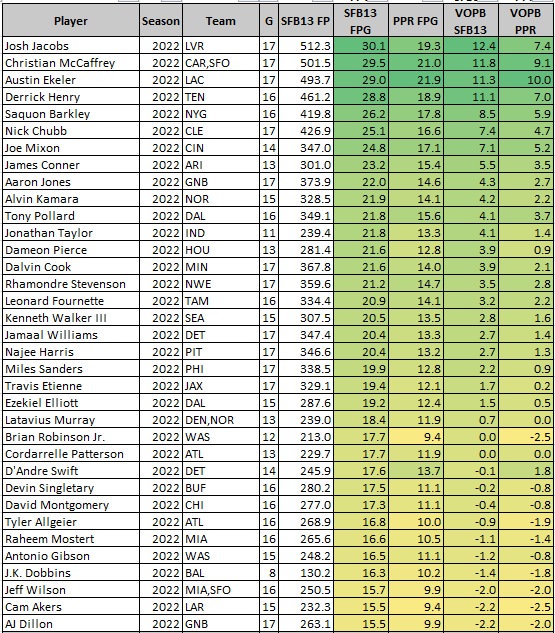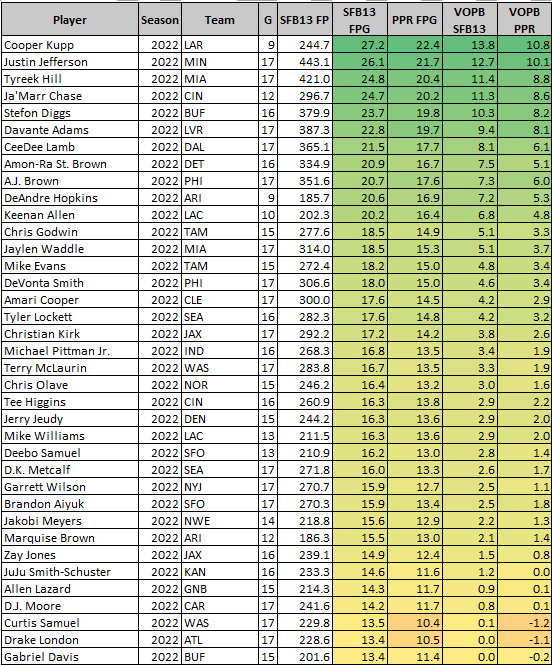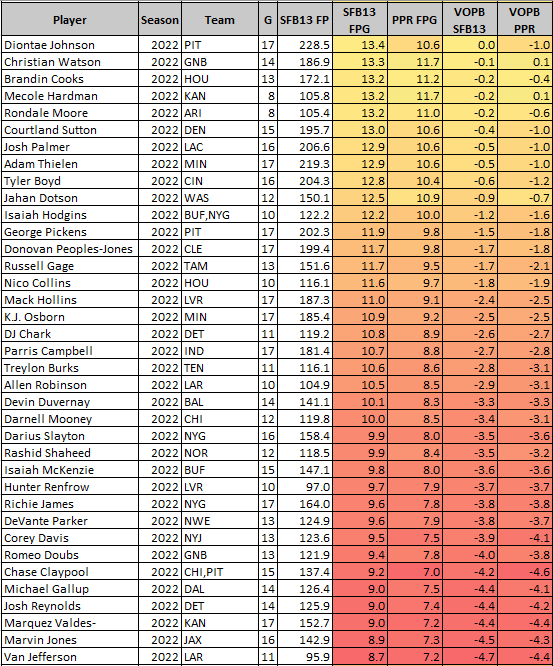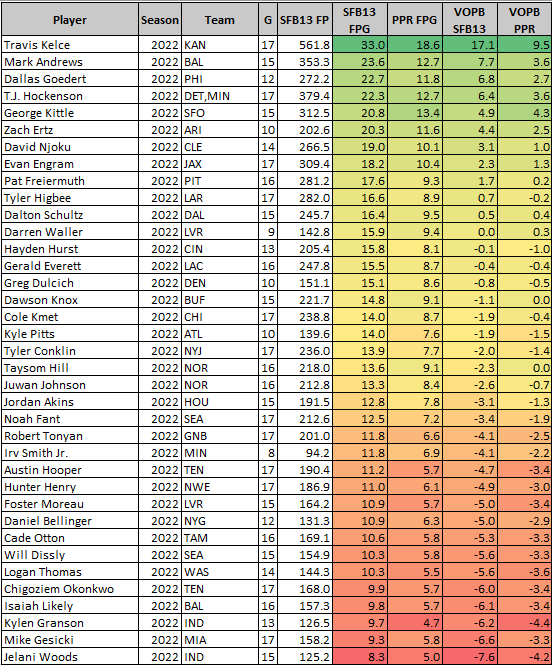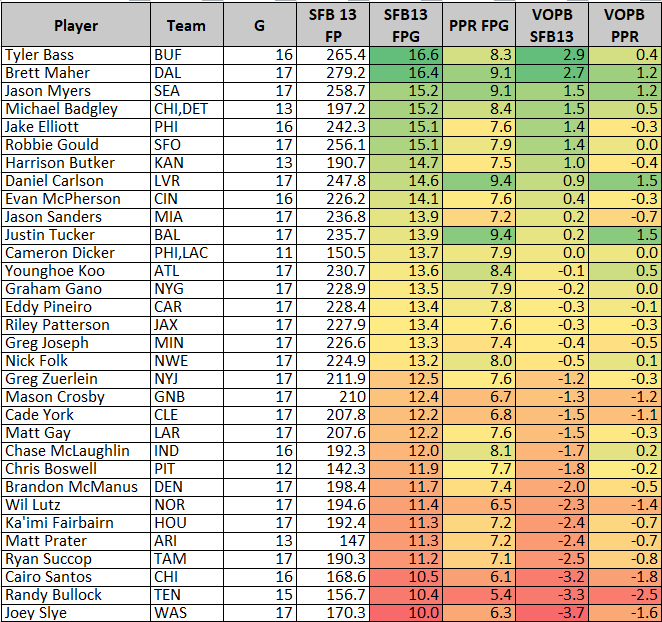Scott Fish Bowl 13 is upon us! I have the scoring, the most valuable players and positions based on how the format would have played out in 2022, and the dankest draft strategies you’ll find.
The full rules can be found here, but some highlights include 6-point passing TDs and bonuses for passing first downs, full-point bonuses for rushing and receiving first downs, massive scoring premiums for tight ends, and yardage-based kicker scoring that awards 3.3 points for a made extra point. Drafts have third-round reversal, lineups feature kickers allowed in FLEX, and it all culminates in a six-week playoff tournament where your season average score is added to your total each week.
That sounds like a lot (and it is), but don’t sweat it too much. This article covers everything you need to crush your competition in the industry’s most beloved charity event.
I’ve applied SFB13’s unique scoring to the 2022 season. This gives us much-needed context for the format, but remember that macro-trends in 2023 may be different than they were in 2022. Don’t get too married to last year’s results while perusing this piece. Full 2022 scoring can be found in each positional section further down.
Overall Scott Fish Bowl 13 Strategy
With QB scoring up across the board, the position will likely be as highly-valued as ever by drafters – starting QB/QB was very common in SFB12. However, the format is now much friendlier to bad real-life QBs. In a PPR league in 2022, you’d have been indifferent between the QB30 (11.8 FPG) and the WR36 (11.6 FPG) for your Superflex slot. In SFB13 scoring, the QB30’s 19.2 FPG narrowly edged out the WR12.
The floor at QB has been raised significantly. That means there should theoretically be less scarcity at the position than in years that featured negative scoring for incompletions. I’ll likely be adding value at RB and WR while others overpay for a QB2 – but the massive cliff in scoring from bottom-tier QBs to other positions means it is even more critically important always to have a QB in your Superflex slot. Drafting 3 or more QBs feels almost required, and job security becomes one of their most important attributes.
The RB position is greatly helped by the first-down scoring bonuses, especially at the top. 2022 was a down year for RBs, but unlike in PPR leagues, the top-six RBs (28.1 FPG) outscored the top-six WRs (24.9 FPG) in SFB13 scoring.
I will be fascinated to see how drafters treat the WR position. Lineups require at least 3 WRs, but WR36 Drake London was outscored by TE19 Tyler Conklin. This means you will often want to flex RBs, TEs, and kickers instead. If SFB drafters leave the WR position for dead as usual, being the first to fill your three WR slots could be a valid contrarian strategy – the WR24 offered a bigger advantage over the WR36 than the QB17 did over the QB24, as well as the RB17 over the RB24. WR3s becoming worthless theoretically means WR1s become more valuable.
Only four players (Josh Allen, Jalen Hurts, Patrick Mahomes, and Joe Burrow) outscored Travis Kelce in SFB13 scoring last year. Kelce averaged 17.1 FPG more than the TE12 in SFB13 scoring – about the same as the gap between Allen and the QB24. There was a 9.4 FPG difference between Kelce and TE2 Mark Andrews – the same as between RB5 Saquon Barkley and RB29 Tyler Allgeier. Kelce is the clear 1.01.
By SFB13 scoring, the K12 would have averaged more FPG than the WR35 last year. The K24 would have averaged as much as the WR49. This means kickers are absolutely going to be FLEX-viable. It also means any deeper skill position players who lack season-long upside are even less appealing – you can always plug in a kicker for a stable floor. Pairing wide range-of-outcomes players like Kadarius Toney with multiple kickers as fall-back options could prove sharp.
Quarterbacks in SFB13
Quarterback scoring is flattened compared to run-of-the-mill PPR leagues. While rushing QBs theoretically benefit heavily from the additional points for first downs and carries, in practice, the 6-point passing TDs and small bonuses for passing first downs raise the baseline considerably.
The elite trio of Josh Allen, Patrick Mahomes, and Jalen Hurts still offer massive value over positional baseline (VOPB) – a simple calculation of a player’s FPG against the baseline player at their position (QB24, RB24, WR36, TE12, or K12). But back-end QB1s like Trevor Lawrence offered less VOPB than mid-tier RB1s and WR1s like Nick Chubb and Amon Ra St. Brown last year.
Last season was a strange one for QB scoring, as the position separated into an “elite” and an “everyone else” tier – which may or may not continue into this year. Either way, you can likely get incredible value at RB and WR if you select from the back half of your draft. Just make sure to compensate with multiple stable QB selections later on. Again, the worst possible outcome here is being caught without a QB2 at some point in the season.
Running Backs in SFB13
The carry and first-down bonuses are a very big deal. In fact, it was Josh Jacobs, not Christian McCaffrey or Austin Ekeler, who would have led the RB position in SFB13 scoring in 2022. RBs often used in short-yardage situations get a boost, while backs who add most of their value in the receiving game get slight downgrades.
Much like in regular PPR leagues, SFB13 VOPB last year incentivized a Hero RB approach – in which you would select a single RB early who you believe has the potential to be one of a few elite producers and then fill out the rest of your lineup before selecting several later RBs to compete for your RB2 slot. This season will not necessarily play out the same, but approaching the position however you normally do is probably valid.
Wide Receivers in SFB13
Top WRs had similar or better VOPB to RBs despite scoring less – mostly because you must start a third WR, and the baseline is lower since WRs get fewer first downs.
This means that WR1s and WR2s matter more than usual, but that WR3s and below are much less valuable since they now score fewer points compared to other FLEX-eligible positions. After my first couple of selections at WR, I would mostly focus on drafting ones I believe have the upside to join the ranks of the top-24. There’s no need to take Tyler Boyd for depth.
Tight Ends in SFB13
The heavier scoring premiums for receptions and first downs at the tight end position serve to lessen the impact of TDs. The position is still Travis Kelce and then everyone else, but the next tier (Mark Andrews, George Kittle, T.J. Hockenson, Dallas Goedert, or Kyle Pitts if you’re into that) should offer about as much VOPB as a back-half RB1 or WR1.
Regardless, I would not be shy about drafting multiple top-24 tight ends. They will be usable in FLEX positions, and TE breakouts will be extraordinarily valuable in this format.
Kickers in SFB13
Even though you can expect 24 kickers to post approximately WR4 numbers, I would still not be the first to draft one. Kickers offer the worst VOPB of any position, with only a 2.9 FPG difference last year between the K1 and K12.
Additionally, kickers have no season-long upside. There is no such thing as a breakout kicker. Given this, along with the flat-scoring distribution, I will still be prioritizing upside WRs and RBs over kickers. Taking a couple late should be fine.
The emphasis on extra points further boosts kickers on good offenses and penalizes ones on mediocre offenses compared to traditional scoring. Tyler Bass was the top-scoring kicker by SFB13 scoring last season, while Justin Tucker (the K1 in traditional formats) was just the K11. If you need help with which to target, my recent kicker article should have you covered – just mentally emphasize everything it says about points for and win totals even more heavily.


